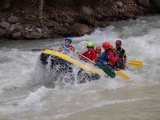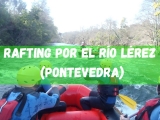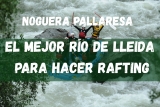
The best of all is that since there are several groups during the descent, you can play games during the process: splashing the person on the next raft, trying to make them capsize, etc. Guaranteed fun without a doubt!
One of the best places to go rafting is Huesca but what do you need to know before going on a descent?
1. Where do I do it?
Fortunately we have many rivers in which to raft in our country. Some examples are the following:
- Cabriel River. It is located in the Valencia area and has several sections of different levels, which makes it suitable for all audiences.

- Genil River. This river is close to Málaga, Córdoba and Seville, being waters for those who want to get started.
- Río Gállego. In the heart of the Huesca Pyrenees, it has sections of various difficulties and is one of the most spectacular rivers that we can find.
- Tajo River. In the area of Alto Tajo (Guadalajara), one of the best areas both for the conditions and for the nature that surrounds it.
2. Do I need to be in physical shape?
It is not necessary that you be an expert athlete but yes, it is very important that you know how to swim. You don't have to be a swimming professional either, but you do have to defend yourself because it is likely that during the descent you will fall into the water :)

3. What do I need to bring?
The various companies that do rafting will leave you with all the necessary equipment to practice it:
- Pneumatic raft and paddle. This is the essential group material for the development of the activity. About 7 people will enter it and the instructor will accompany you during the descent. He will be the one in charge of giving you the basic notions and the orders that you have to follow to overcome the obstacles and pass the rapids without capsizing.
- Neoprene. As it is likely that during the descent you will end up in the water, this suit will prevent you from getting cold, as it protects against water and, when wet, a layer of water enters between the skin and the suit, making that our body heat will warm.

- Helmet. To prevent you from hitting a branch or rock.
- Life jacket. If you fall into the water it will help you float.
4. What is the minimum age to do the activity?
There are descents for all ages. In fact, many schools choose this activity among their excursions with schoolchildren and some families choose to take a tour together. It will depend on the route taken, but approximatelyfrom 8-10 years old it can be done without problem.

5. Are there levels of difficulty?
Yes. Normally companies choose the sections of the river based on the experience that the participants have. There are up to 6 levels:
- Levels I and II. These are the ideal river areas for children and novices, as they are calm waters, with almost no risk of falling into the water and the rapids that we find in them are not too strong. li>
- Level III. An intermediate level with small waves that are somewhat more pronounced and with a faster descent of the water. Some steeper slopes and more abundant obstacles can be found.
- Level IV. An advanced level that has stronger, more irregular rapids, with rocks to avoid and more complicated maneuvers to do.

- Level V. Reserved only for experts. There are many currents, all of them very fast, long, irregular... You need to have rescue and safety knowledge.
- Level VI. This is the most extreme of all, even being on the border between navigable and non-navigable.
It depends on what you are looking for, what level you have and whether or not you are going with children. But you should know that the months of April-May are the most fun, as they are the months of thaw in which the water falls with more force, producing more rapids. This is the general rule, although it will also depend on the river where you are going to do the activity, of course.

Generally speaking, it can be practiced between the months of April to September, because if you fall into the water it will not be as cold as at other times of the year.
7. Does it carry any risk?
As long as you go to a river with a level adapted to your experience and follow the recommendations of the instructor who goes with you and the group on the raft, there should be no problem.
8. How long does the tour take?
Depending on the level of the river where you do this activity, the season and the company who carries it out. But it generally lasts an average of approximately 2 hours in the water.

And you, have you already done rafting? Do you plan to do it? Do you think it would fit for the bachelor party you have in mind?












